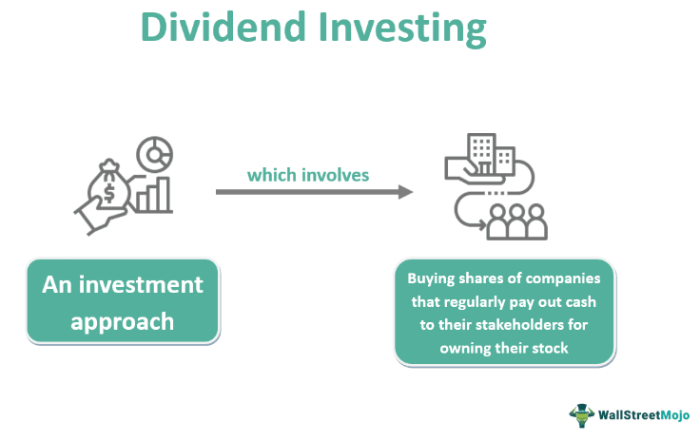Diving into the world of dividend investing, this guide offers a deep look into a lucrative investment strategy that many overlook. With a focus on generating passive income and long-term wealth, dividend investing has become a popular choice among savvy investors looking to grow their portfolios. Let’s explore the ins and outs of this intriguing financial approach.
What is Dividend Investing?
Dividend investing is a strategy where investors focus on purchasing stocks that pay out dividends on a regular basis.
When investors buy shares of a company that offers dividends, they become eligible to receive a portion of the company’s profits. These payments are typically distributed quarterly or annually.
Examples of Companies Known for Dividend Payouts
- Johnson & Johnson: A healthcare company that has a long history of consistently paying dividends.
- Procter & Gamble: A consumer goods company known for its stable dividend payments.
- AT&T: A telecommunications company that has been a favorite among dividend investors for its high yield.
Benefits of Dividend Investing
- Steady Income: Investors can rely on regular dividend payments for income, providing stability in volatile markets.
- Compound Growth: Reinvesting dividends can lead to compounded returns over time, increasing overall wealth.
- Historical Performance: Dividend-paying stocks have historically outperformed non-dividend-paying stocks, offering potential for long-term growth.
How to Start Dividend Investing?
To begin dividend investing, it’s essential to follow a few key steps as a beginner. Researching dividend-paying companies is crucial to make informed investment decisions. Additionally, understanding different investment strategies can help you maximize your returns and build a diversified portfolio.
Researching Dividend-Paying Companies
- Look for companies with a history of consistent dividend payments.
- Check the company’s financial health and stability to ensure they can sustain dividend payments.
- Consider the company’s growth potential and industry trends to assess future dividend growth.
Different Investment Strategies
- Dividend Growth Investing: Focus on companies that consistently increase their dividend payouts over time.
- High Dividend Yield Investing: Invest in companies with high dividend yields, even if it means sacrificing growth potential.
- Dividend Reinvestment Plans (DRIPs): Automatically reinvest dividends to purchase more shares of the company.
Factors to Consider in Dividend Investing
When diving into dividend investing, there are several key factors to keep in mind that can impact your investment decisions. From the type of dividend stocks you choose to the economic conditions affecting the market, understanding these factors is crucial for successful dividend investing.
Dividend Yield vs. Dividend Growth
- Dividend Yield: This metric represents the percentage of income you receive relative to the stock price. A higher dividend yield may seem attractive, but it could also indicate a company in distress or an unsustainable dividend.
- Dividend Growth: Focuses on companies that consistently increase their dividend payouts over time. While the initial yield might be lower, the potential for higher future income can be more beneficial in the long run.
Impact of Economic Conditions
- During economic downturns, companies may struggle to maintain their dividend payments, leading to cuts or suspensions. It’s essential to assess the overall economic health and stability before investing in dividend stocks.
- Inflation can also erode the purchasing power of your dividends over time. Companies with a history of increasing dividends above inflation rates can help protect your income stream.
Significance of a Company’s Dividend Payout Ratio
- The dividend payout ratio indicates the percentage of earnings a company pays out as dividends. A high payout ratio may signal that the company is returning too much of its profits to shareholders, leaving little room for future growth or investment.
- A low payout ratio, on the other hand, could signify that the company is retaining more earnings for expansion or reinvestment in the business, potentially leading to future dividend growth.
Dividend Reinvestment Plans (DRIPs)

Dividend Reinvestment Plans, commonly known as DRIPs, are investment programs offered by companies that allow shareholders to automatically reinvest their cash dividends into additional shares of the company’s stock. This means that instead of receiving cash payments, investors receive more shares, which can lead to compound growth over time.
Benefits of Reinvesting Dividends through DRIPs
Reinvesting dividends through DRIPs offers several benefits:
- Compound Growth: By reinvesting dividends, investors can benefit from compound growth as they acquire more shares, which in turn generate more dividends.
- Cost Efficiency: DRIPs often allow investors to purchase additional shares at a discount or with no commission fees, making it a cost-effective way to increase their holdings.
- Automatic Investing: DRIPs automate the process of reinvesting dividends, eliminating the need for manual reinvestment and ensuring a disciplined approach to investing.
Companies Offering DRIP Programs
Many companies offer DRIP programs to their shareholders. Some examples include:
| Company | Stock Ticker |
|---|---|
| Johnson & Johnson | JNJ |
| The Coca-Cola Company | KO |
| Procter & Gamble | PG |
Advantages of DRIPs versus Taking Cash Dividends
When comparing DRIPs to taking cash dividends, there are several advantages:
- Long-Term Growth: DRIPs promote long-term growth through compound interest, allowing investors to benefit from the power of compounding over time.
- Cost Savings: DRIPs often come with lower fees and no commission charges, making them a cost-effective way to reinvest dividends.
- Convenience: By automatically reinvesting dividends, DRIPs offer a convenient way for investors to grow their wealth without the need for active management.
